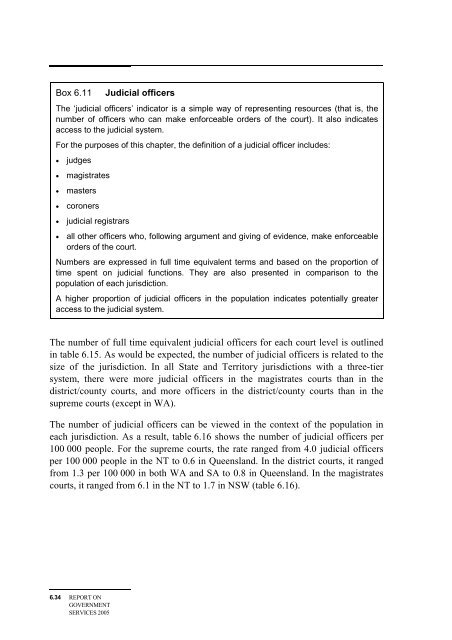PDF 0.4 MB
PDF 0.4 MB
PDF 0.4 MB
Create successful ePaper yourself
Turn your PDF publications into a flip-book with our unique Google optimized e-Paper software.
Box 6.11<br />
Judicial officers<br />
The ‘judicial officers’ indicator is a simple way of representing resources (that is, the<br />
number of officers who can make enforceable orders of the court). It also indicates<br />
access to the judicial system.<br />
For the purposes of this chapter, the definition of a judicial officer includes:<br />
• judges<br />
• magistrates<br />
• masters<br />
• coroners<br />
• judicial registrars<br />
• all other officers who, following argument and giving of evidence, make enforceable<br />
orders of the court.<br />
Numbers are expressed in full time equivalent terms and based on the proportion of<br />
time spent on judicial functions. They are also presented in comparison to the<br />
population of each jurisdiction.<br />
A higher proportion of judicial officers in the population indicates potentially greater<br />
access to the judicial system.<br />
The number of full time equivalent judicial officers for each court level is outlined<br />
in table 6.15. As would be expected, the number of judicial officers is related to the<br />
size of the jurisdiction. In all State and Territory jurisdictions with a three-tier<br />
system, there were more judicial officers in the magistrates courts than in the<br />
district/county courts, and more officers in the district/county courts than in the<br />
supreme courts (except in WA).<br />
The number of judicial officers can be viewed in the context of the population in<br />
each jurisdiction. As a result, table 6.16 shows the number of judicial officers per<br />
100 000 people. For the supreme courts, the rate ranged from 4.0 judicial officers<br />
per 100 000 people in the NT to 0.6 in Queensland. In the district courts, it ranged<br />
from 1.3 per 100 000 in both WA and SA to 0.8 in Queensland. In the magistrates<br />
courts, it ranged from 6.1 in the NT to 1.7 in NSW (table 6.16).<br />
6.34 REPORT ON<br />
GOVERNMENT<br />
SERVICES 2005
















